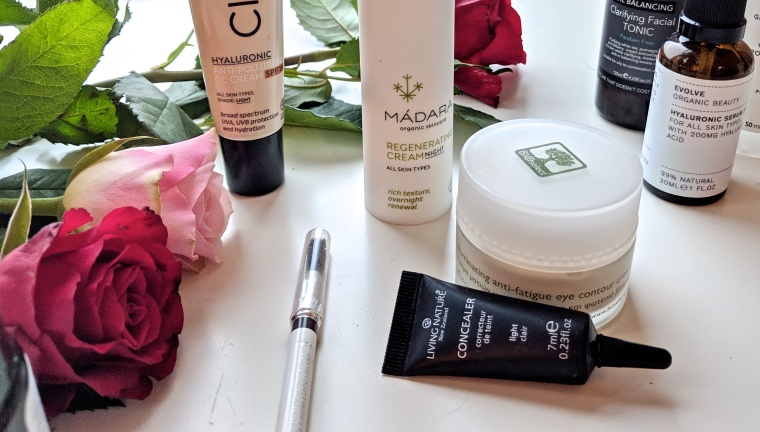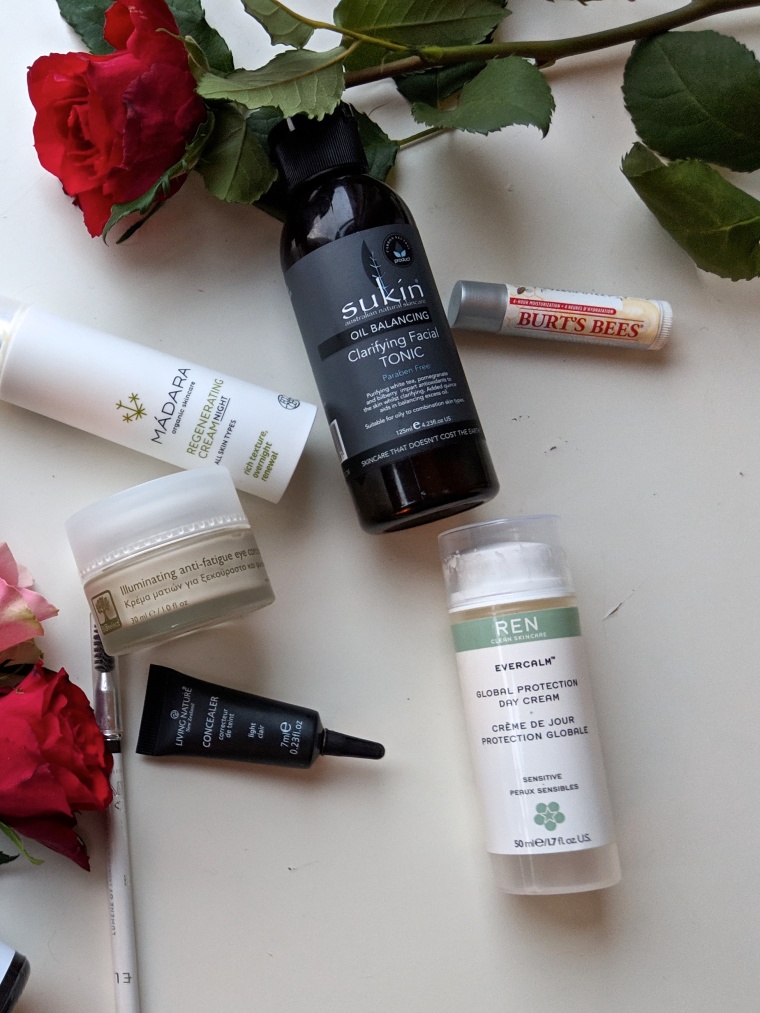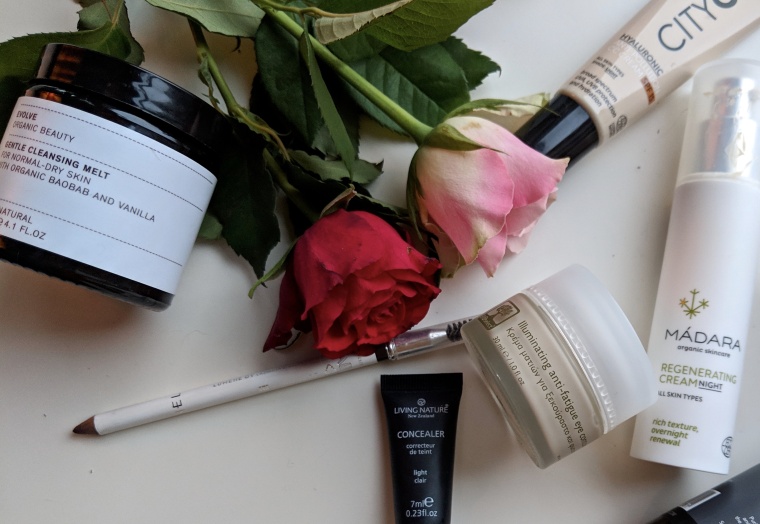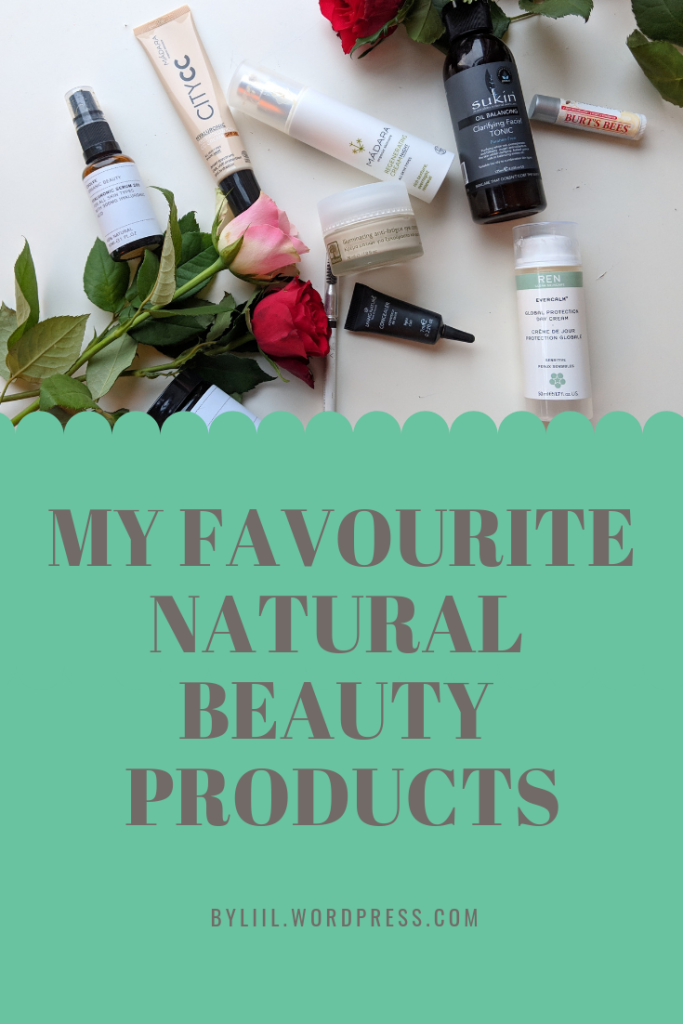One of the first posts I wrote on my blog was about beauty, which is funny as I decided to concentrate on sustainable fashion, but I’ve realised my focus is much wider than that. I wanted to write about beauty a little bit because I was going through a phase when I was looking for products that were cruelty-free and natural, instead of buying the chemical-infused products from the high street which were tested on animals. I have come a long way since then trying many products, some of which didn’t suit me, some of which did and I am finally in a place where I am happy with the selection I have and wanted to share it in case anybody else is looking for great natural beauty products. I must say that I am not a vegan and although some of these products might be vegan, it is not the thing that I require from the products I use. I look for natural ingredients, not tested on animals, organic if possible, sustainably sourced and produced if possible, small company, zero waste if possible. Not all of my values match in each of these products and therefore at some point, the list might change if I find something better.

This list is only for the products that I love and use continuously and have bought several times or am planning to keep buying. It is missing shampoo, as I will be doing a separate post about the different shampoo bars that I like. As well as, the body wash, as I keep changing this from different vegan and small company versions to Lush bars. If there is something else I haven’t named yet it’s because I haven’t found one that I like or use multiple different ones.
Ren Evercalm Global Protection Day Cream
Vegan/Cruelty-free/Manufactured in the UK/Paraben free/Sulphate free/Silicone free/Not tested on animals
“Designed to repair skins natural barriers, calm, hydrate and soothe sensitive skin” is what Ren say about their day cream. It has blackcurrant seed oil, seabuckthorn berry oil and Camellia oil as natural bio-active ingredients.
For me, this is the only moisturiser that is hydrating enough without being greasy for the day. It has slightly thick creamy consistency which feels lovely on the skin and it works great as the base for make-up as well.
– The packaging isn’t the best, as it is a plastic pump bottle where it can be difficult to get the exact amount of product that you want, and you can never get every single drip out of there. I wish it was also certified organic. It is a bit pricy but it lasts me a long time!
Madara Regenerating Night Cream
Not tested on animals/Natural/Certified organic/Vegan
“Antioxidant rich moisturiser with skin regenerating extracts of Northern Hop, Barley germs and Tomato.” This moisturiser has a lovely creamy consistency and it really feels regenerating when I use it during the night. On its own, it is not enough to hydrate my skin during the coldest winter months, but at other times it is very hydrating. The price is fairly high but it is for a 50ml bottle in which you get a lot of product.
– The same as for the previous, it is a plastic pump bottle and once actually I had to do a complaint as there was no product coming from the bottle no matter how much I was pumping it. It could also more clear on its use of parabens, silicons and sulphates.

BioSelect Illuminating Anti Fatigue Eye Contour Cream
Certified organic/Not tested on animals/Silicone free/Paraben free
This eye cream is creamy and thick, so it hydrates well, but it doesn’t get greasy. It lights up my under eyes, although not quite as well as an illuminator, but that is not what I look from it. My under eyes get easily dry, but I haven’t had any problems since I started using this one. The jar, in which it comes, is handy and really big. For the price, you pay you get a lot of product!
– The jar has a plastic top, which is not ideal.
Natural/Vegan/Cruelty-free/Eco-friendly/No toxic chemicals/Handcrafted
This is a lovely quite light oil with the scent of rosehip. It’s so light that I could use it as a moisturiser and it is hydrating and balancing enough. I love taking it with me when I go on holidays as it is so hydrating! This is made in small batches and hand made in the UK which makes it all that much more special. The price is very reasonable as well!
– The only issue really is that it’s not certified organic, but it’s such a small brand it might be financially not feasible for them yet.
Not tested on animals/Cruelty-free/Natural/Paraben free/Phthalate free/Petrolatum-free
I am quite happy to use any of them, but at the moment my favourites are Ultra Conditioning or Coconut and Pear, both are very moisturising and smell nice. Their lip balms are very moisturising, especially these two! It is quite low-priced.
– I would prefer if it would not be under an unethical company. Also, the packaging is plastic and although it is natural ingredients it is not certified organic.
Natural/Vegan/Cruelty-free/Eco-friendly/No toxic chemicals/Handcrafted
Very gentle and hydrating serum. It doesn’t have much of a scent, but I quite like that. It is handcrafted in the UK in small batches and won lots of awards, which I am not surprised about.
– My skin seems to need quite a lot of this product and I run out of it quite quickly, which can get quite pricey.

Natural/Vegan/Cruelty-free/Eco-friendly/No toxic chemicals/Handcrafted
Similarly to previous Evolve products, it is handcrafted in the UK in small batches. This is the best cleanser I have found and I absolutely love it! It is thick and luxurious. It soothes, calms and hydrates, and leaves your skin feeling moisturised but clean. They recommend mixing a little of bit of it with water that you can then use as a milky cleanser, but I like to massage it into my skin, let it work for a minute or two and then wipe it away with a hot and moist muslin cloth. It gets away my make-up quite well too. For a cleanser, it might feel that the price is high, but this actually lasts me for ages as you only need a little bit of the product.
– It is a bit pricey and is not certified organic. Also, the lid of the jar is plastic.
Evolve Radiant Glow Organic Face Mask
Natural/Vegan/Cruelty-free/Eco-friendly/No toxic chemicals/Handcrafted
This is a combination of mask and scrub with a delicious chocolatey scent, almost good enough to eat. You can lather it on and let it stay for a few minutes to let it sink in, or just use it as a scrub. Mixing it with water makes it milky but it still has lovely little beads to scrub (no microplastics here). This is absolutely lovely to use and although I didn’t originally really like the scent of chocolate in it (it is quite strong and just makes you want to eat chocolate), I don’t might the scent now. It is also hand made in small batches in the UK.
– The lid is plastic and it is not certified organic.
Sukin Oil Clarifying Facial Tonic
Natural/Not tested on animals/Vegan/Paraben free/Sulphate free/Silicon free
Gentle tonic that isn’t drying, but also gets rid of make-up and is refreshing. I usually use it after cleansing my skin and in the mornings before applying moisturiser to hydrate. I love that it also has only a few ingredients and no nasties.
– The only minus I have is the packaging which is plastic.

Certified organic/Natural/Not tested on animals/Cruelty-free/Paraben free/Sulphate free
“This anti-pollution CC cream corrects all skin tone imperfections, including dullness, redness, sallowness and dark spots. Scientifically proven to shield your skin from urban pollutants to protect skin microbiome, prevent clogged pores and inflammation. With broad spectrum UVA/UVB sunscreen and deeply hydrating hyaluronic acid.” That pretty much sums it up. For me, it works excellently leaving nice even and glowy but not shiny finish. My face feels moisturised throughout the day and not cloggy at all. It has a nice and creamy consistency that works well with a foundation brush but could work with a sponge as well.
– It is really pricey and although the product lasts for quite a long time I also usually need quite a lot of it per application. It is also in plastic packaging which is not ideal.
Living Nature Natural Concealer
Not-tested on Animals/Vegetarian/Paraben free/Natural product/Certified Organic
Concealer with a creamy consistency that conceals well without looking cakey and is not drying. It is the only concealer that doesn’t dry my under eyes that I’ve tried. And the shade is great for under eyes.
– The last one I bought got a bit watery, probably because it got too warm, but I rather enjoyed the creamy consistency. Also, it is very pricey but little goes a long way!
Lumene Extreme Precision Eyebrow Pencil
Natural/Cruelty-free/Not tested on animals/Sustainable ingredient sourcing/Paraben free/Phthalates free
This is an eyebrow pencil with the right shade for me. It is difficult to find good eyebrow pencils for some reason and I’ve been long hunting for one until I found this one from Lumene when I was in Finland the last time. I like the spread of the colour and that I have a brush on the other end.
– It is not certified organic. I know that all Lumene products are natural, but I had to look for the information instead of it being on the page so it would be easily recognisable. Also, it has plastic caps.

I do love to try new products alongside using these and sometimes I manage to find a better product than the one I am already using. So this list might look a bit different even in a years time.
What are your favourite natural beauty products? Let me know in the comments box below as I would love to hear them!
With love,
Lii
Other articles you might be interested in:
The Green Eco Box – Subscription Box That Does Good





































